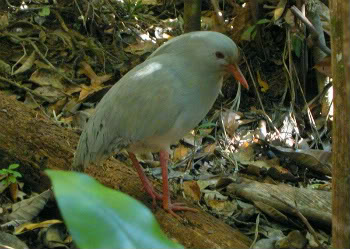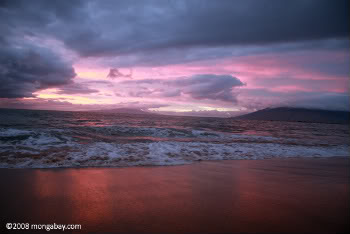|
|
If the world is to save biodiversity, island are key, according to a new study in the Proceedings of the National Academy of Sciences. The study found that while islands have fewer overall species than continental areas of the same size, they have far more endemic species, i.e. animals and plants that can be found no-where else in the world.
“Normally you want to focus on the most diverse places to protect a maximum number of species,” said Holger Kreft, a post-doctoral fellow at the University of California, San Diego and one of the two main authors of the study, “but you also want to focus on unique species which occur nowhere else.”
 The endangered kagu Rhynochetos jubatus of New Calendonia. Photo by: Miguel Vences |
To find out just how unique island biodiversity is compared to continental, Kreft and colleagues split the globe into 90 regions and then calculated the biodiversity of plants and vertebrate animals of each. With this model they discovered islands were eight to nine times richer in unique species.
What island has the most endemic species? The study points to New Caledonia in the southwest Pacific, which contains several notable stand-outs. For example, the endangered kagu—a nearly flightless bird—is the only surviving member of the family Rhynochetidae; while, the Amborella is thought to be the last survivor of an ancient linegae of understory shurbs.
Unique plants are especially abundant on islands. The study found that while island’s make-up less than four percent of Earth’s land area, they are home to nearly a quarter of the world’s known plants, 70,000 of which are not found on the continents.
 Wailea Beach on the Hawaiian island of Maui. With 317 species labeled threatened or endangered in Hawaii, the island-state has the most endangered biodiversity in the US. Photo by: Rhett A.Butler |
Endemic island species are under considerable stress: due to small populations and limited habitats extinction is always a very real possibility. Modeling future human impacts on biodiversity up to 2100, the researchers found that island biodiversity will face greater pressure than continental biodiversity, due largely to human land-use, including deforestation and agricultural expansion.
“That threat is expected to accelerate particularly rapidly on islands where access to remaining undeveloped lands is comparatively easy” said Gerold Kier, project leader at the University of Bonn and lead author of the study. In New Caledonia, for example, an economy based on mining has devastated many wildlife areas.
“We now have new and important data in our hands, but still have no simple solutions for nature conservation,” Kreft concludes. “In particular, we need to answer the question how protected areas with their flora and fauna can complement each other in the best way. The part played by ecosystems, for example their ability to take up the green-house gas carbon dioxide, should be increasingly taken into account.”
Related articles
Rare bird rediscovered on ‘most pristine’ island in southeast Asia
(10/23/2008) Scientist have rediscovered the endangered Wetar Ground-dove (Gallicolumba hoedtii), one of the world’s least known birds, 100 years after it was last seen on the remote Indonesian island of Wetar, reports Columbidae Conservation, a UK-based conservation group.
Rat killing spree may save endangered wildlife on remote Pacific islands
(05/26/2008) A team of scientists is on its way to remote the Phoenix Islands Protected Area to eradicate rats that are threatening populations of indigenous seabirds, reports conservation International, an environmental group.
Scientists propose conservation areas for the unique island of Sulawesi
(01/06/2008) Little-known Sulawesi may be the world’s most strangely shaped island: with four large peninsulas jutting outward, the island could either resemble a mangled lower-case ‘k’ or an upside-down emaciated mermaid—depending on one’s perspective. However when Dr. Charles Cannon states that the island is “one of the most unique spots on Earth”, he is not referring to Sulawesi’s shape but its ecology.